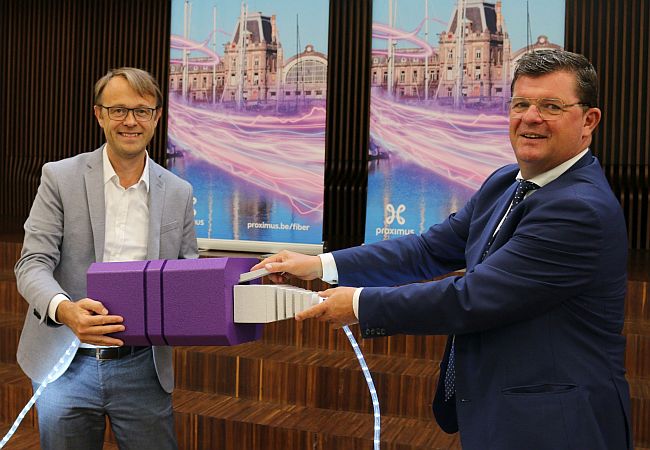
Belgian fibre optic network
Belgian telecom operator Proximus is accelerating the construction of its fibre optic network. COVID-19 has boosted working from home, for which the fibre optic network's ultra-fast digital access is ideally suited. Even after the corona crisis, working from home will continue.
Speed and bandwidth of copper and fibre networks are very different. There is a delay when electromagnetic waves are sent through fibreglass or copper wire. The fibre network is a high frequency network and offers exceptional bandwidth. The exceptionally high frequency, which is situated between microwaves and the visible light, allows a very high bandwidth.
In a family context, everyone can simultaneously surf the Internet, watch TV, stream videos and play games without any hiccups or loss of quality. Linear television watching with fixed programming on the channels is losing popularity, to the benefit of streaming services. 5G, data in the Cloud, the internet of Things: no problem with the fibre optic network.
This has not escaped the attention of the financial world. Some traders between the major financial centres in London and Frankfurt use radio links. Even fractions of seconds are decisive for a stock trader or dealer to buy or sell and to make profit or loss. However, tall masts and associated equipment make point-to-point connections far too expensive for normal commercial use. Fibre optic networks, on the other hand, are ideal for all broadband applications, both download and upload.
CTO of Proximus, Geert Standaert, is convinced that Proximus will become the reference for fibre optics in Europe. 23 telecom operators have already concluded an agreement with Proximus to use the fibre network. The current fibre network can handle speeds of up to 10 Gigabit/second, even 50 Gigabit/second ought to be attainable with fibre optics.
We are experiencing an evolution that even the pioneers of the internet more than 30 years ago would never have dared to imagine.

On the left CTO Geert Standaert, on the right the mayor of Ostend
who symbolically connects his port city to the fibre optic network.
Advantages of the fibre optic network
An operational fibre optic network transports data at high speed. Light propagates in a vacuum at the fantastic speed of 299,792 km per hour.Speed and bandwidth of copper and fibre networks are very different. There is a delay when electromagnetic waves are sent through fibreglass or copper wire. The fibre network is a high frequency network and offers exceptional bandwidth. The exceptionally high frequency, which is situated between microwaves and the visible light, allows a very high bandwidth.
FTTH
The use of copper wire between the central distribution box of the provider and a home impedes superfast broadband. FTTH, or Fibre To The Home, removes this bottleneck. The high bandwidth of the fibre optic network creates all kinds of possibilities.In a family context, everyone can simultaneously surf the Internet, watch TV, stream videos and play games without any hiccups or loss of quality. Linear television watching with fixed programming on the channels is losing popularity, to the benefit of streaming services. 5G, data in the Cloud, the internet of Things: no problem with the fibre optic network.
Wireless radio signal faster than fibre optic network
Wireless electromagnetic waves from the radio amateurs bridge great distances slightly faster than the transport of the same electromagnetic waves through copper or fibre optic cables.This has not escaped the attention of the financial world. Some traders between the major financial centres in London and Frankfurt use radio links. Even fractions of seconds are decisive for a stock trader or dealer to buy or sell and to make profit or loss. However, tall masts and associated equipment make point-to-point connections far too expensive for normal commercial use. Fibre optic networks, on the other hand, are ideal for all broadband applications, both download and upload.
Opening up of fibre optic network to all operators
Proximus presented "Fibre for Belgium" in December 2016. They stepped up the effort considerably in March 2020, with the ultimate goal of achieving a national fibre network coverage of 70%. Specialists are currently installing 1,000 connections per day, and this will increase to 6,000 to 8,000 connections at a later stage.CTO of Proximus, Geert Standaert, is convinced that Proximus will become the reference for fibre optics in Europe. 23 telecom operators have already concluded an agreement with Proximus to use the fibre network. The current fibre network can handle speeds of up to 10 Gigabit/second, even 50 Gigabit/second ought to be attainable with fibre optics.
We are experiencing an evolution that even the pioneers of the internet more than 30 years ago would never have dared to imagine.

On the left CTO Geert Standaert, on the right the mayor of Ostend
who symbolically connects his port city to the fibre optic network.


